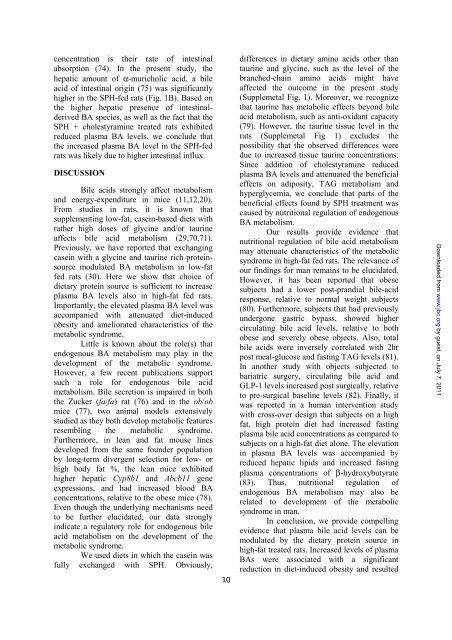The obesogenic effects of polyunsaturated fatty acids are dependent ...
The obesogenic effects of polyunsaturated fatty acids are dependent ...
The obesogenic effects of polyunsaturated fatty acids are dependent ...
You also want an ePaper? Increase the reach of your titles
YUMPU automatically turns print PDFs into web optimized ePapers that Google loves.
concentration is their rate <strong>of</strong> intestinal<br />
absorption (74). In the present study, the<br />
hepatic amount <strong>of</strong> α-muricholic acid, a bile<br />
acid <strong>of</strong> intestinal origin (75) was significantly<br />
higher in the SPH-fed rats (Fig. 1B). Based on<br />
the higher hepatic presence <strong>of</strong> intestinalderived<br />
BA species, as well as the fact that the<br />
SPH + cholestyramine treated rats exhibited<br />
reduced plasma BA levels, we conclude that<br />
the increased plasma BA level in the SPH-fed<br />
rats was likely due to higher intestinal influx.<br />
DISCUSSION<br />
Bile <strong>acids</strong> strongly affect metabolism<br />
and energy-expenditure in mice (11,12,20).<br />
From studies in rats, it is known that<br />
supplementing low-fat, casein-based diets with<br />
rather high doses <strong>of</strong> glycine and/or taurine<br />
affects bile acid metabolism (29,70,71).<br />
Previously, we have reported that exchanging<br />
casein with a glycine and taurine rich proteinsource<br />
modulated BA metabolism in low-fat<br />
fed rats (30). Here we show that choice <strong>of</strong><br />
dietary protein source is sufficient to increase<br />
plasma BA levels also in high-fat fed rats.<br />
Importantly, the elevated plasma BA level was<br />
accompanied with attenuated diet-induced<br />
obesity and ameliorated characteristics <strong>of</strong> the<br />
metabolic syndrome.<br />
Little is known about the role(s) that<br />
endogenous BA metabolism may play in the<br />
development <strong>of</strong> the metabolic syndrome.<br />
However, a few recent publications support<br />
such a role for endogenous bile acid<br />
metabolism. Bile secretion is impaired in both<br />
the Zucker (fa/fa) rat (76) and in the ob/ob<br />
mice (77), two animal models extensively<br />
studied as they both develop metabolic features<br />
resembling the metabolic syndrome.<br />
Furthermore, in lean and fat mouse lines<br />
developed from the same founder population<br />
by long-term divergent selection for low- or<br />
high body fat %, the lean mice exhibited<br />
higher hepatic Cyp8b1 and Abcb11 gene<br />
expressions, and had increased blood BA<br />
concentrations, relative to the obese mice (78).<br />
Even though the underlying mechanisms need<br />
to be further elucidated, our data strongly<br />
indicate a regulatory role for endogenous bile<br />
acid metabolism on the development <strong>of</strong> the<br />
metabolic syndrome.<br />
We used diets in which the casein was<br />
fully exchanged with SPH. Obviously,<br />
10<br />
differences in dietary amino <strong>acids</strong> other than<br />
taurine and glycine, such as the level <strong>of</strong> the<br />
branched-chain amino <strong>acids</strong> might have<br />
affected the outcome in the present study<br />
(Supplemetal Fig. 1). Moreover, we recognize<br />
that taurine has metabolic <strong>effects</strong> beyond bile<br />
acid metabolism, such as anti-oxidant capacity<br />
(79). However, the taurine tissue level in the<br />
rats (Supplemetal Fig 1) excludes the<br />
possibility that the observed differences were<br />
due to increased tissue taurine concentrations.<br />
Since addition <strong>of</strong> cholestyramine reduced<br />
plasma BA levels and attenuated the beneficial<br />
<strong>effects</strong> on adiposity, TAG metabolism and<br />
hyperglycemia, we conclude that parts <strong>of</strong> the<br />
beneficial <strong>effects</strong> found by SPH treatment was<br />
caused by nutritional regulation <strong>of</strong> endogenous<br />
BA metabolism.<br />
Our results provide evidence that<br />
nutritional regulation <strong>of</strong> bile acid metabolism<br />
may attenuate characteristics <strong>of</strong> the metabolic<br />
syndrome in high-fat fed rats. <strong>The</strong> relevance <strong>of</strong><br />
our findings for man remains to be elucidated.<br />
However, it has been reported that obese<br />
subjects had a lower post-prandial bile-acid<br />
response, relative to normal weight subjects<br />
(80). Furthermore, subjects that had previously<br />
undergone gastric bypass, showed higher<br />
circulating bile acid levels, relative to both<br />
obese and severely obese objects. Also, total<br />
bile <strong>acids</strong> were inversely correlated with 2hr<br />
post meal-glucose and fasting TAG levels (81).<br />
In another study with objects subjected to<br />
bariatric surgery, circulating bile acid and<br />
GLP-1 levels increased post surgically, relative<br />
to pre-surgical baseline levels (82). Finally, it<br />
was reported in a human intervention study<br />
with cross-over design that subjects on a high<br />
fat, high protein diet had increased fasting<br />
plasma bile acid concentrations as comp<strong>are</strong>d to<br />
subjects on a high-fat diet alone. <strong>The</strong> elevation<br />
in plasma BA levels was accompanied by<br />
reduced hepatic lipids and increased fasting<br />
plasma concentrations <strong>of</strong> β-hydroxybutyrate<br />
(83). Thus, nutritional regulation <strong>of</strong><br />
endogenous BA metabolism may also be<br />
related to development <strong>of</strong> the metabolic<br />
syndrome in man.<br />
In conclusion, we provide compelling<br />
evidence that plasma bile acid levels can be<br />
modulated by the dietary protein source in<br />
high-fat treated rats. Increased levels <strong>of</strong> plasma<br />
BAs were associated with a significant<br />
reduction in diet-induced obesity and resulted<br />
Downloaded from www.jbc.org by guest, on July 7, 2011
















